Atlassian Bundle
How Does the Atlassian Company Thrive?
From a $10,000 credit card start to a multi-billion dollar enterprise, the Atlassian SWOT Analysis reveals a fascinating journey. This global powerhouse has revolutionized how teams collaborate and build, dominating the software landscape. Discover how this unconventional beginning shaped a company that now serves over 300,000 customers worldwide.
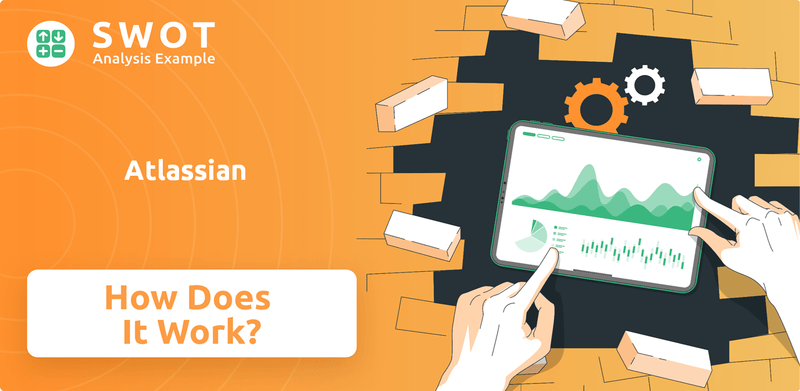
This exploration into How Atlassian works will uncover the secrets behind its success, from its innovative Atlassian products like Jira and Confluence to its strategic shift to the cloud. We'll examine Atlassian's business model, its commitment to AI, and its impact on project management. Understanding the Atlassian ecosystem is key for anyone looking to understand the future of work and the dynamics of the enterprise software market.
What Are the Key Operations Driving Atlassian’s Success?
The core of how the Atlassian company works revolves around providing a suite of software tools designed to improve team collaboration, project management, and software development. These tools, including Jira, Confluence, and Bitbucket, cater to a wide range of users, from small teams to large enterprises. This approach allows Atlassian to address diverse needs within the market.
The Atlassian value proposition is centered on streamlining workflows, improving communication, and enabling data-driven decision-making. By offering a comprehensive ecosystem of products, Atlassian helps teams achieve more together. This focus on efficiency and collaboration is a key driver of its success.
The company's operational processes are heavily reliant on continuous technology development and a strong emphasis on research and development (R&D). This commitment to innovation allows Atlassian to deliver competitive products and stay ahead in the market. The 'System of Work' philosophy connects technology and business teams to accelerate progress and maximize impact.
Atlassian offers a range of products, including Jira, Confluence, Bitbucket, Jira Service Management, Trello, and Loom. Jira started as a bug-tracking tool and evolved into a project management solution. Confluence is a collaborative workspace, and Bitbucket is for code management. These products support various functions within organizations.
The customer base includes a wide spectrum, from small teams and individual users to large enterprises. Over 40% of Fortune 500 companies use Jira Service Management. This diverse customer base highlights the broad appeal and applicability of Atlassian's products across different organizational sizes and sectors.
Operations are driven by continuous technology development and R&D. The launch of Jira Product Discovery in Q4 2023, which has grown by over 150% year-over-year and acquired over 14,000 customers, is a good example. Atlassian's cloud platform supports up to 50,000 users on a single Jira Cloud instance and 150,000 users in Confluence.
The Atlassian Marketplace, launched in 2012, has generated over $3 billion in sales. This ecosystem approach deepens the integration of Atlassian's tools into customer workflows. The company uses a 'bottom-up' adoption model, where individual teams adopt products, leading to broader organizational integration.
The company's core capabilities translate into customer benefits by streamlining workflows, improving communication, and enabling data-driven decision-making. This helps teams achieve more together. The 'bottom-up' adoption model and focus on enterprise deals contribute to Atlassian's success.
- Offers a comprehensive suite of software tools.
- Focuses on continuous technology development and R&D.
- Leverages a vast ecosystem of third-party developers.
- Uses a 'bottom-up' adoption model.
Atlassian SWOT Analysis
- Complete SWOT Breakdown
- Fully Customizable
- Editable in Excel & Word
- Professional Formatting
- Investor-Ready Format
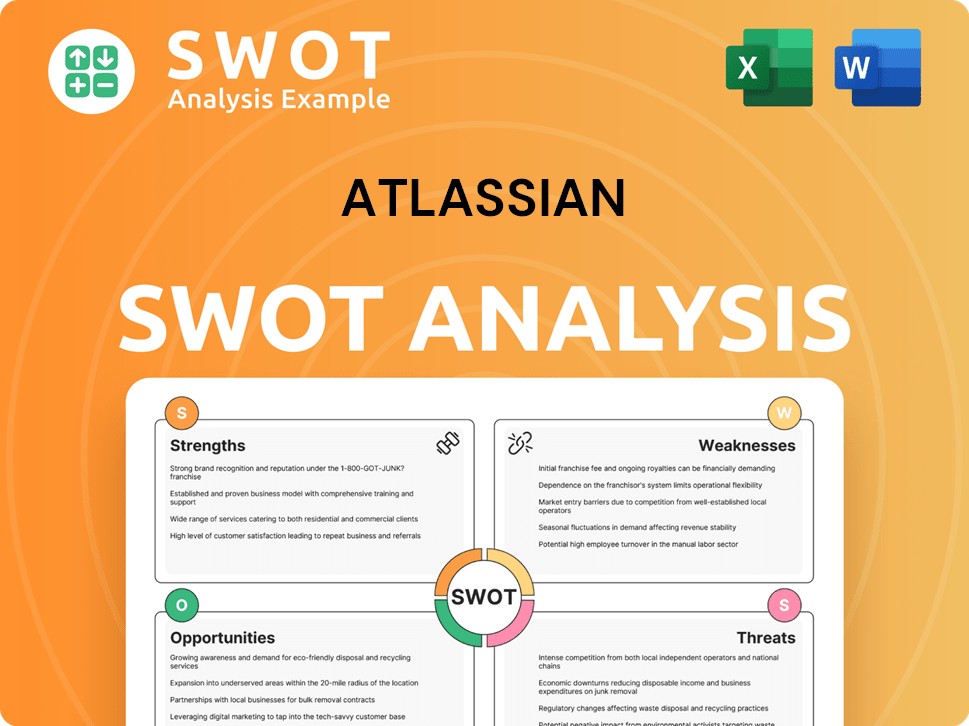
How Does Atlassian Make Money?
Understanding the financial dynamics of the Atlassian company involves a deep dive into its revenue streams and monetization strategies. Atlassian's business model is primarily driven by subscriptions, which provide recurring revenue from its suite of software products. This approach allows the company to build a predictable and scalable financial foundation, crucial for long-term growth and investment.
The Atlassian company has demonstrated consistent revenue growth. For the fiscal year 2024, the company's total revenue reached $4.36 billion, reflecting a substantial increase of 23.31% compared to the previous year. Continuing this upward trend, the twelve months ending March 31, 2025, saw revenue climb to $4.96 billion, a 19.12% year-over-year increase, highlighting the company's strong market position and effective strategies.
Subscription revenue is the backbone of Atlassian's financial performance. In the third quarter of fiscal year 2025, subscription revenue accounted for $1.27 billion out of a total revenue of $1.36 billion. This segment is further divided into Cloud, Data Center, and Marketplace and other revenue, each contributing to the overall financial health of the company. The growth in these areas showcases the effectiveness of Atlassian's strategic initiatives and its ability to adapt to market demands.
Cloud revenue is a significant growth driver for Atlassian. It is projected to increase by approximately 27.0% year-over-year for the full fiscal year 2025. This growth reflects the company's successful transition to cloud-based solutions and the increasing demand for flexible, accessible software.
Data Center revenue is also contributing positively. It is expected to grow by approximately 21.5% year-over-year in FY25. This growth is driven by price increases, seat expansion, and cross-selling opportunities within the existing customer base.
The Atlassian Marketplace also generates substantial revenue. In fiscal year 2024, it facilitated over $1.1 billion in gross purchases of third-party apps. This demonstrates the strength of the Atlassian ecosystem and the value it provides to both customers and third-party developers.
Atlassian uses a tiered pricing model to encourage customers to upgrade to premium and enterprise editions. This strategy allows for the monetization of advanced features and capabilities, such as those offered by Jira Product Discovery Premium, driving higher average revenue per user.
Cross-selling is a key monetization strategy for Atlassian. The company leverages its diverse product portfolio, integrating tools like Jira, Confluence, and Jira Service Management to create a more unified platform experience, encouraging customers to adopt multiple Atlassian products.
The strategic shift to cloud has been a significant monetization driver. The end-of-support for Server offerings in FY24 prompted migrations to Cloud and Data Center, leading to better-than-expected revenue from these segments. This transition has not only increased revenue but also improved the company's long-term growth prospects.
Atlassian's ability to generate revenue is underpinned by several key strategies. These include a subscription-based model, tiered pricing, cross-selling, and strategic acquisitions. The company's focus on cloud solutions and its expansion into new markets further contribute to its financial success. For a more in-depth look at Atlassian's business model, you can read this article about Atlassian's business model.
- Subscription Model: Recurring revenue from software access.
- Tiered Pricing: Encourages upgrades to premium and enterprise versions.
- Cross-Selling: Integrates products like Jira and Confluence.
- Cloud Transition: Drives revenue through cloud migrations.
- Market Expansion: Targets new segments like healthcare and finance.
- Strategic Acquisitions: Expands product portfolio.
Atlassian PESTLE Analysis
- Covers All 6 PESTLE Categories
- No Research Needed – Save Hours of Work
- Built by Experts, Trusted by Consultants
- Instant Download, Ready to Use
- 100% Editable, Fully Customizable
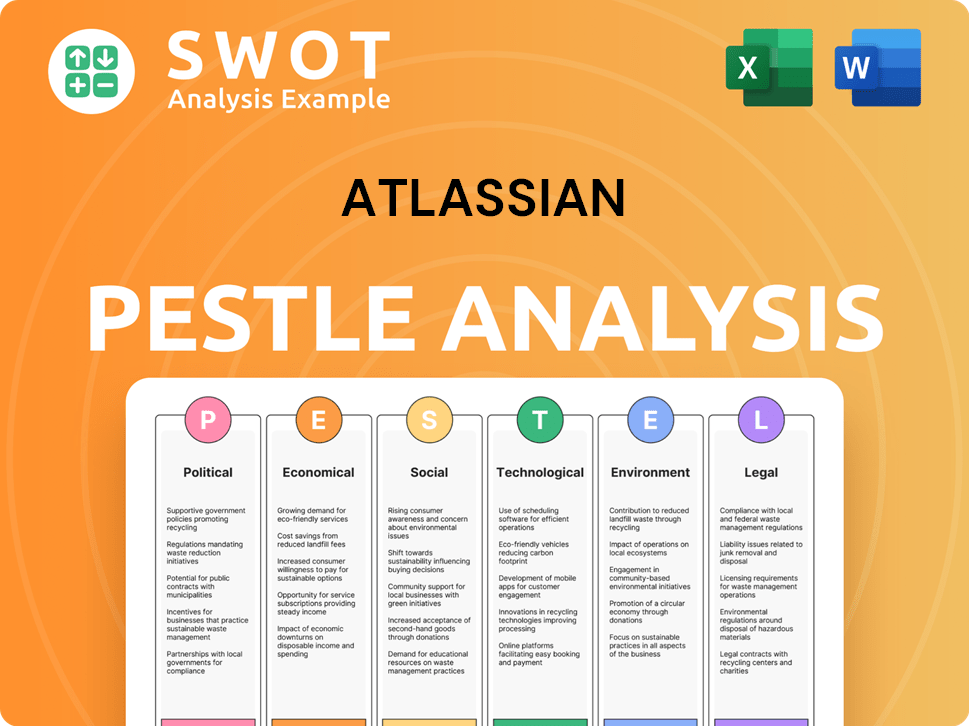
Which Strategic Decisions Have Shaped Atlassian’s Business Model?
The journey of the Atlassian company has been marked by significant milestones and strategic moves that have shaped its operations and financial performance. A pivotal moment was the decision to end support for its Server offerings in fiscal year 2024, successfully migrating more customers to its Cloud and Data Center offerings than initially projected. This strategic shift led to strong migration activity and contributed significantly to Cloud and Data Center revenue growth.
In fiscal year 2024, the company achieved over $4.3 billion in revenue and surpassed 300,000 customers. Furthermore, the company reached an annual revenue run rate of $5 billion in Q2 FY25. Despite macroeconomic uncertainties impacting key revenue growth drivers, the company has responded by emphasizing innovation and strategic initiatives, particularly in its Cloud platform, AI capabilities, and enterprise sales.
The focus on growing large enterprise accounts has been a key strategy, with a record number of deals with over $1 million in annual contract value in Q2 FY25. This demonstrates the company's ability to attract and retain large customers, driving revenue growth and solidifying its market position. The company continues to adapt to new trends by integrating AI across its product portfolio, launching Rovo—an AI-powered enterprise assistant—and introducing AI-driven automation rules.
Achieved over $4.3 billion in revenue in fiscal year 2024. Surpassed 300,000 customers during the same period. Reached an annual revenue run rate of $5 billion in Q2 FY25.
Ended support for Server offerings, driving customers to Cloud and Data Center. Focused on growing large enterprise accounts, securing a record number of deals. Integrated AI across its product portfolio, launching Rovo and AI-driven automation.
Strong brand reputation and loyal customer base. Extensive investment in R&D, delivering world-class products. Unified platform with seamless integration. Unique 'Teamwork Graph' enabling AI capabilities.
Continued investment in Cloud platform and AI capabilities. Expansion of enterprise sales efforts. Further development of the 'Teamwork Graph' to enhance AI features. Focus on customer retention and expansion.
The company's competitive advantages are multifaceted, including a strong brand reputation and a loyal customer base. The company's extensive investment in R&D allows it to deliver world-class products at competitive prices.
- Strong brand reputation and loyal customer base.
- Extensive investment in R&D.
- Technology leadership with a unified platform.
- The 'Teamwork Graph' powered by over 20 years of data.
Atlassian Business Model Canvas
- Complete 9-Block Business Model Canvas
- Effortlessly Communicate Your Business Strategy
- Investor-Ready BMC Format
- 100% Editable and Customizable
- Clear and Structured Layout
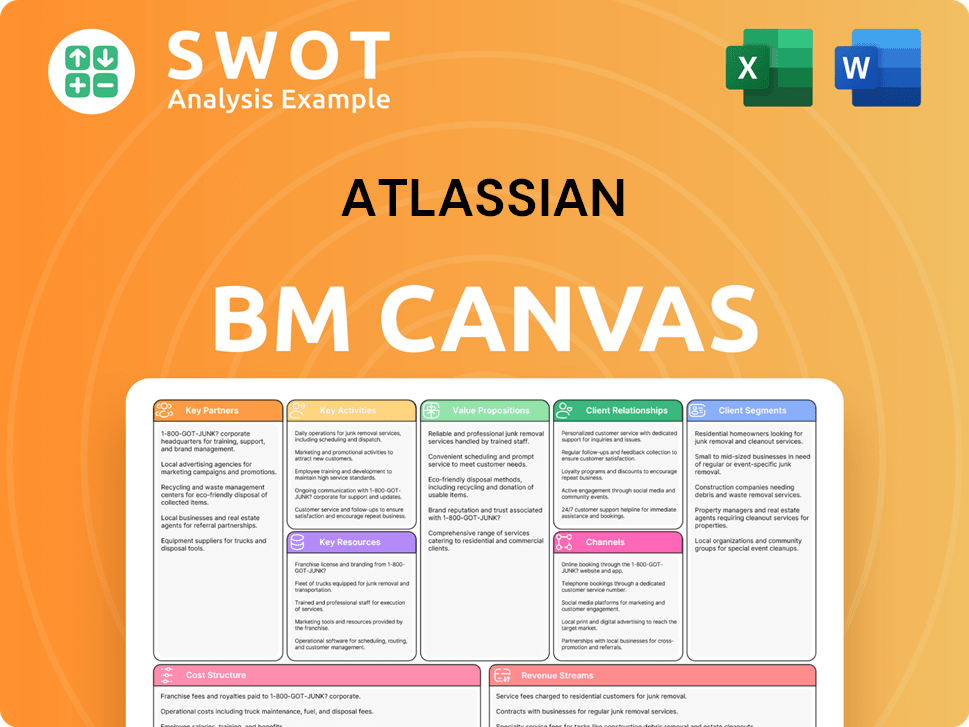
How Is Atlassian Positioning Itself for Continued Success?
The Atlassian company holds a strong position in the enterprise software market, especially in tools for software development, project management, and team collaboration. Although not as large in revenue as some tech giants, Atlassian has a substantial customer base, with over 300,000 customers, and is deeply embedded within software development organizations. They are recognized as a leader in knowledge management solutions and marketing work management platforms. Their main competitors include Microsoft Teams, GitLab, Asana, and Monday.com, but Atlassian has carved out a distinct niche with its integrated suite of collaboration tools.
Despite its strong position, Atlassian faces several risks. Macroeconomic uncertainty can negatively affect paid seat expansion, cross-selling, and customer retention. The company is also navigating the complexities of its cloud migration strategy, as growth in Data Center revenue is expected to slow down as customers increasingly adopt cloud solutions. Competition remains a constant factor, with other companies also investing heavily in AI and collaboration tools. Furthermore, while Atlassian has shown strong revenue growth, it has historically operated with GAAP net losses, which is a factor for investors to consider.
Atlassian is a leader in enterprise software, particularly in software development and project management. Their integrated suite of tools provides a distinct advantage in the market. They have a large customer base, with over 300,000 customers, demonstrating strong market penetration.
Macroeconomic factors and competition pose risks to Atlassian. Cloud migration and the need to maintain customer retention are also key challenges. The company's historical GAAP net losses are a factor for investors to consider.
Atlassian aims to achieve over $10 billion in annual revenue in the next five years. Key strategies include focusing on the enterprise segment, AI innovation, and integrating technology and business teams. They are investing heavily in AI, with Rovo at the center of their human-AI collaboration vision.
Atlassian is focusing on enterprise customers, AI, and integrating technology and business teams. They plan to strengthen their cloud platform, expand data residency options, and increase scalability. The company is committed to balancing operational discipline with investments in strategic growth areas.
Atlassian is focused on accelerating revenue growth, aiming for over $10 billion in annual revenue within the next five years. They are investing in AI, notably with Rovo, and integrating AI capabilities into products like Jira and Confluence.
- Enterprise segment focus
- AI innovation and integration
- Strengthening cloud platform and scalability
- Balancing operational discipline with strategic investments
Atlassian Porter's Five Forces Analysis
- Covers All 5 Competitive Forces in Detail
- Structured for Consultants, Students, and Founders
- 100% Editable in Microsoft Word & Excel
- Instant Digital Download – Use Immediately
- Compatible with Mac & PC – Fully Unlocked
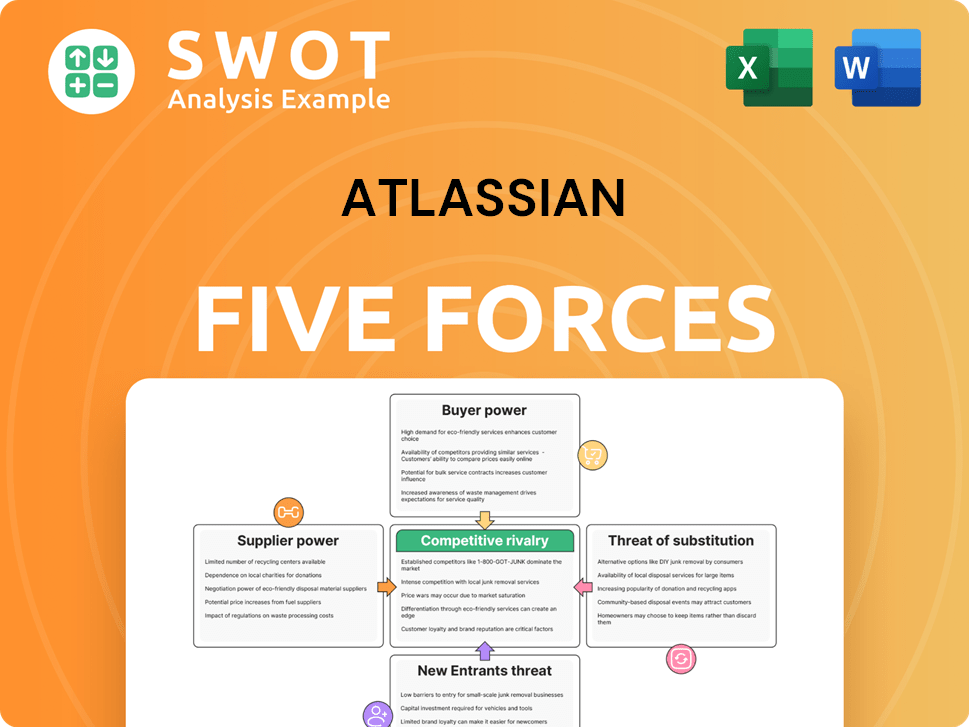
Related Blogs
- What are Mission Vision & Core Values of Atlassian Company?
- What is Competitive Landscape of Atlassian Company?
- What is Growth Strategy and Future Prospects of Atlassian Company?
- What is Sales and Marketing Strategy of Atlassian Company?
- What is Brief History of Atlassian Company?
- Who Owns Atlassian Company?
- What is Customer Demographics and Target Market of Atlassian Company?
Disclaimer
All information, articles, and product details provided on this website are for general informational and educational purposes only. We do not claim any ownership over, nor do we intend to infringe upon, any trademarks, copyrights, logos, brand names, or other intellectual property mentioned or depicted on this site. Such intellectual property remains the property of its respective owners, and any references here are made solely for identification or informational purposes, without implying any affiliation, endorsement, or partnership.
We make no representations or warranties, express or implied, regarding the accuracy, completeness, or suitability of any content or products presented. Nothing on this website should be construed as legal, tax, investment, financial, medical, or other professional advice. In addition, no part of this site—including articles or product references—constitutes a solicitation, recommendation, endorsement, advertisement, or offer to buy or sell any securities, franchises, or other financial instruments, particularly in jurisdictions where such activity would be unlawful.
All content is of a general nature and may not address the specific circumstances of any individual or entity. It is not a substitute for professional advice or services. Any actions you take based on the information provided here are strictly at your own risk. You accept full responsibility for any decisions or outcomes arising from your use of this website and agree to release us from any liability in connection with your use of, or reliance upon, the content or products found herein.